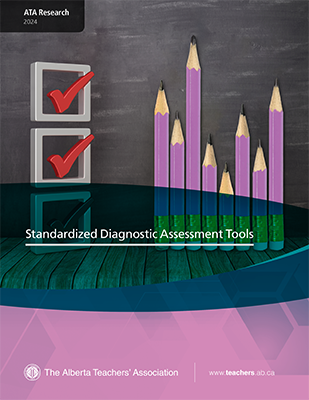What teachers need is the discretion to decide when diagnostic testing can be useful and the ability to provide timely, impactful support for all students. Given our research, I encourage the government to assess the value of their own assessments”
—Jason Schilling, President, ATA
"Timed tests have brought my Grade 1 and 2 classes to tears. They are stressed and crack under pressure."
—Respondant
Alberta’s education system is contending with an explosion of testing, especially elementary literacy and numeracy screening tests. These assessments have added roughly four days of work to elementary teachers’ responsibilities this year, with no corresponding reduction in other demands. Coupled with the introduction of a new curriculum, the increased testing is adding to teachers’ workloads without alleviating any existing responsibilities.
This emphasis on standardized assessments for our youngest learners in Alberta is also interrupting and displacing the very heart of teaching and learning practice: relationships. The time teachers once devoted to getting to know students at the beginning of the year — observing their individual needs, strengths, talents and learning styles — is being displaced by these mandatory tests and the time it takes to enter the associated data.
The Alberta Teachers’ Association (ATA) recently conducted a comprehensive study of standardized diagnostic assessment tools (SDATs), in the form of the mandatory literacy and numeracy testing, with Richelle Marynowski of the University of Lethbridge. Alberta Education has stated that “These screening assessments will help teachers identify students in the critical early years who are most in need of additional support and provide a means to monitor growth over time.” However, the ATA’s research findings reveal that the reality in classrooms does not align with these aspirations.
What follows is a summary of six critical issues brought forward in this ATA research study. These six findings underscore the urgent need for the government to reconsider its approach to SDATs.
1. Negative impact on students
The ATA study revealed that SDATs — and the mandatory literacy and numeracy screeners in particular — are contributing to significant stress and anxiety among Alberta students, particularly young learners in Division 1, English language learners (ELL) and students with exceptionalities. One respondent shared, “The timed aspect creates undue pressure and stress. Children are coming to school and all they want to do is perform well and please their teachers. For many students, they develop a sense of failure when these tests are designed to be nearly impossible to finish.”
Furthermore, inappropriate and developmentally misaligned content, such as asking Grade 1 students to work with a number line spanning 0 to 100, intensifies students’ feelings of frustration and failure. These experiences not only undermine children’s confidence but also impact their long-term perceptions of what it means to learn when they begin the year with nothing but a battery of stressful tests.
2. Limited usefulness of SDAT results
Teachers report that SDAT results are often delayed and lack actionable insights, rendering them ineffective for timely intervention. One teacher expressed frustration: “We won’t get the results for this year probably until end of April. . . . It makes no sense.” Stated another, “Not provided with norms (as initially promised), nor with any direction on how to interpret the results OR how the data should drive instruction.”
It is clear that Alberta teachers struggle to translate these results into meaningful supports for students. This disconnect highlights a systemic gap between data collection and actionable classroom strategies. In actuality, most teachers can sense, based on their professional judgment and wisdom, which students are struggling within the first two weeks of regular instruction. The testing appears to be more of an accountability mechanism as opposed to a diagnostic tool of inherent value.
3. Misalignment with curriculum and developmental needs
A critical issue identified in the report is the misalignment of SDAT content with curricular goals and students’ developmental stages. For instance, teachers highlighted that numeracy assessments often require advanced skills that students have not yet been taught. One teacher stated, “The tests assume that the teacher has taught all the outcomes of the Grade 1 program by the end of December and all students are capable of demonstrating this understanding regardless of ELL [English language learner] level, communication delays, prior exposure, etc.” Another similarly explained, “Some of the questions are asking about the number 205. They barely know the number 10. Not fair, stressful,” underscoring how much of the tested material is developmentally out of reach for early learners.
This misalignment not only renders the assessments ineffective but also undermines their fundamental validity as tools for measuring student progress.
4. Lack of support and resources
Alberta teachers reported a critical lack of support in administering SDATs, including insufficient training and inadequate access to substitute teachers. One respondent lamented, “No sub time provided to administer or input data into Power School [software]. We rely on each other in the school to cover for us when administering the [test], for example.” This situation exemplifies what others have also described as “relying on each other … to cover for us,” with teachers having little formal guidance on the process.
Teachers are often forced to use personal time to manage the technical and logistical demands of these assessments, further intensifying their already heavy workloads. The lack of systemic support underscores the need for better resource allocation to ease the burden on Alberta’s teachers.
5. Excessive time demands
SDATs are consuming valuable instructional time, disrupting the classroom environment and straining teachers’ ability to focus on building relationships and fostering learning. The timing of assessments, particularly at the start of the school year, compounds these challenges. As one teacher explained, “September and October are busy months trying to get to know students and establish routines and expectations. Adding additional expectations was exhausting and challenging.” Another respondent emphasized, “We work hard to build up student confidence, then we force them to write tests on outcomes they haven’t fully covered, and any confidence we have built is destroyed.”
The cumulative effect of lost teaching days, estimated to be four full days (and more for some classes), raises questions about the efficacy and priorities of these assessments.
6. Inadequate inservicing for teachers
The Marynowski study found that most teachers received little to no training on administering or interpreting SDATs. Teachers reported a specific lack of information about the scores, noting that the provided data offers minimal or no actionable insights. As one educator put it, “Not provided with norms … nor with any direction on how to interpret the results OR how the data should drive instruction.”
This lack of preparedness not only undermines the validity of the assessments but also places undue stress on teachers and school leaders, who are left to navigate these tools without adequate supports and resources.
Further evidence
In January 2025, the ATA conducted further research into the impact of increased screening tests by conducting a pulse research study of more than 1,400 Alberta elementary teachers.

Here are some of the teacher comments from that study.

The ATA’s research makes it clear: Alberta’s students and teachers deserve a system that values meaningful support over metrics and empowers educators to truly respond to their students’ needs.

A call to action
As the profession faces unsustainable work intensification, declining job satisfaction and a system that prioritizes data over meaningful learning, the findings from this study demand urgent action. Rather than empowering teachers to respond to students’ unique struggles and real-time needs, the current mandatory screeners appear to be reducing teaching to data collection for those far away from classrooms in the name of “accountability,” feeding the seemingly ever-expanding bureaucratic demands on Alberta teachers and school leaders at the expense of genuine learning.
This misplaced focus risks reducing education to numbers while neglecting the human connections and professional judgment that are at the heart of teaching. The ATA’s research makes it clear: Alberta’s students and teachers deserve a system that values meaningful support over metrics and empowers educators to truly respond to their students’ needs.

Standardized Diagnostic Assessment Tools
The full report can be found on the ATA website under Professional development > Education Research, at teachers.ab.ca


